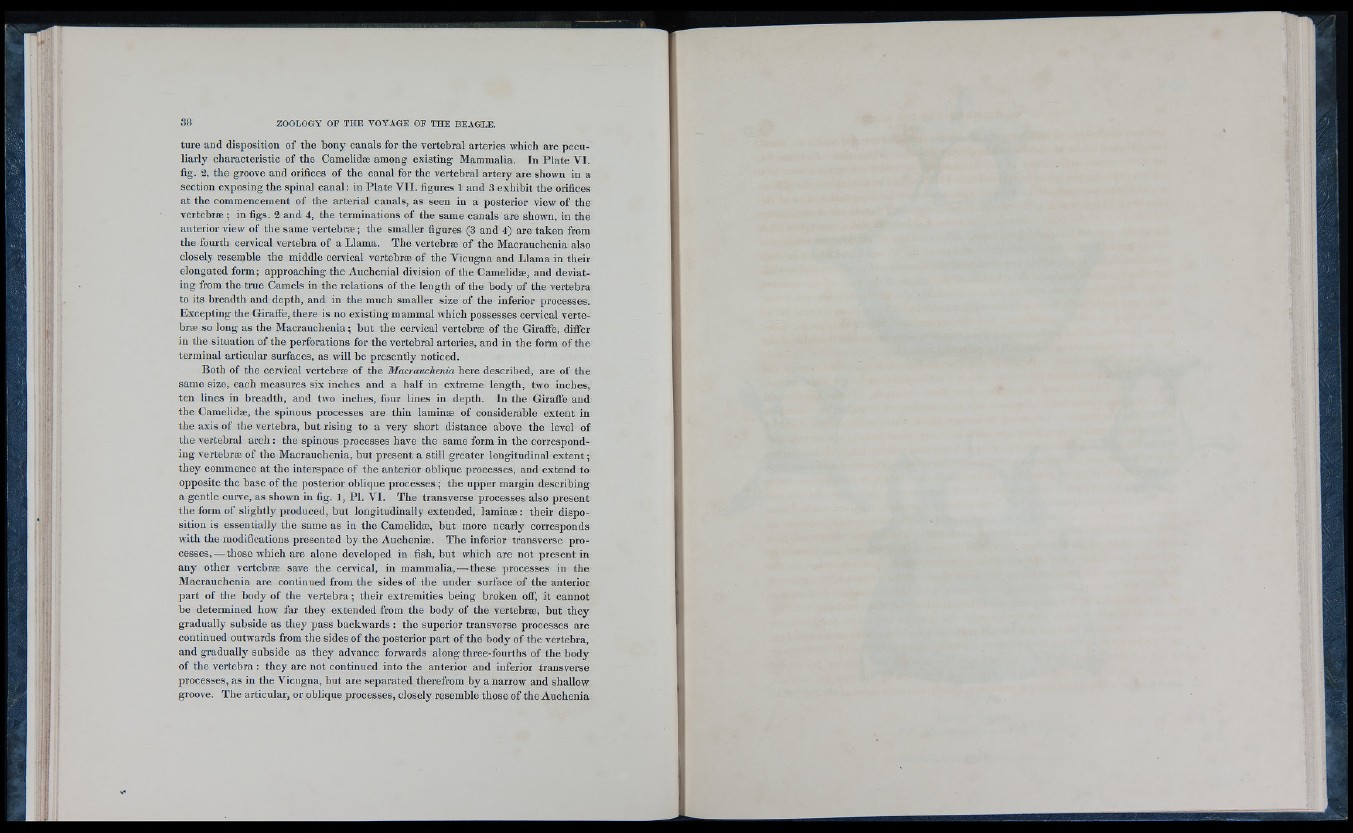
ture and disposition o f the bony canals for the vertebral arteries which are peculiarly
characteristic o f the Camelidæ among ex isting Mammalia. In P la te VI.
fig. 2, the groove and orifices o f the canal for the vertebral artery are shown in a
section exposing the spinal canal : in P la te V II . figures 1 and 3 exhibit the orifices
at the commencement o f the arterial canals, as seen in a posterior view o f the
vertebræ ; in figs. 2 and 4, the terminations o f the same canals are shown, in the
anterior view o f the same vertebræ ; the smaller figures (3 and 4) are taken from
the fourth cervical vertebra o f a Llama. The vertebræ o f the Macrauchenia also
closely resemble the middle cervical vertebræ o f the Vicugna and Llama in their
elongated form; approaching the Auchenial division o f the Camelidæ, and deviating
from the true Camels in the relations o f the length o f the body o f the vertebra
to its breadth and depth, and in the much smaller size o f the inferior processes.
Ex cepting the Giraffe, there is no ex isting mammal which p o ssesses cervical vertebræ
so long as the Macrauchenia; but the ceiwical vertebræ o f the Giraffe, differ
in the situation o f the perforations for the vertebral arteries, and in the form o f the
terminal articular surfaces, as will be presently noticed.
Both o f the cervical vertebræ o f the Macrauchenia here described, are o f the
same size, each measures six inches and a h a lf in extreme length, two inches,
ten line s in breadth, and two inches, four lines in depth. In the Giraffe and
the Camelidæ, the spinous processes are thin laminæ o f considerable extent in
the axis o f the vertebra, but rising to a very short distance above the level o f
the vertebral arch : the spinous processes have the same form in the correspondin
g vertebræ o f the Macrauchenia, but present a still greater longitudinal ex tent ;
they commence at the interspace o f the anterior oblique processes, and extend to
opposite the base o f the posterior oblique processes ; the upper margin describing
a gentle curve, as shown in fig. 1, PL V I. Th e transverse processes also present
the form o f slightly produced, but longitudinally extended, laminæ : their disposition
is essentially the same as in the Camelidæ, but more nearly corresponds
with the modifications presented by the Aucheniæ. Th e inferior transverse proc
e ss e s ,— those which are alone developed in fish, but which are not present in
any other vertebræ save the cervical, in mammalia, — these processes in the
Macrauchenia are continued from the sides o f the under surface o f the anterior
part o f the body o f the vertebra ; their extremities being broken off, it cannot
b e determined how far they extended from the body o f the vertebræ, but they
gradually subside as they pass backwards : the superior transverse processes are
continued outwards from the sid es o f the posterior part o f the body o f the vertebra,
and gradually subside as they advance forwards along three-fourths o f the body
o f the vertebra : they are not continued into the anterior and inferior transverse
processes, as in the Vicugna, but are separated therefrom by a narrow and shallow
groove. The articular, or oblique processes, c lose ly resemble those o f the Auchenia